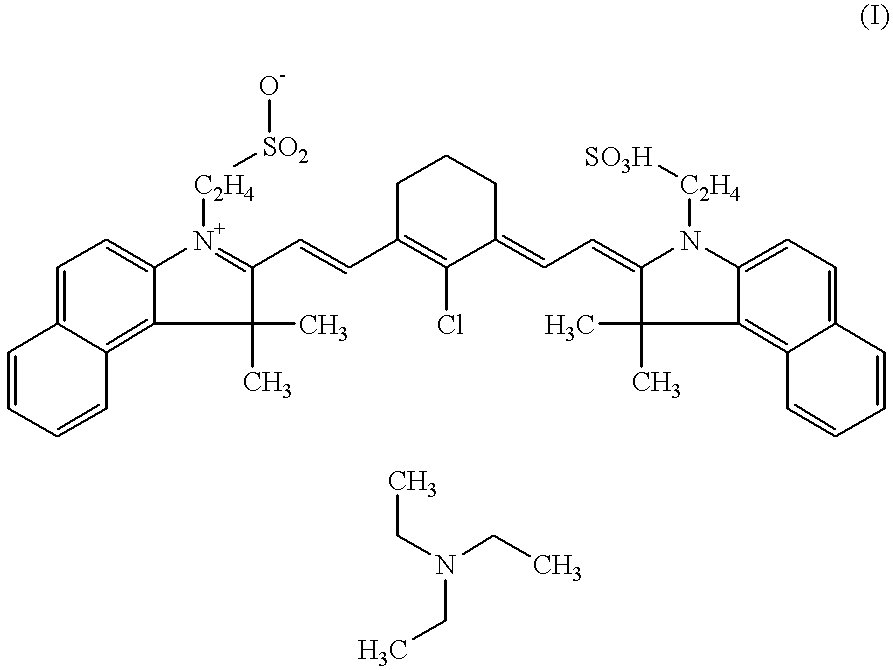Heat mode sensitive imaging element for making positive working printing plates
- Summary
- Abstract
- Description
- Claims
- Application Information
AI Technical Summary
Benefits of technology
Problems solved by technology
Method used
Image
Examples
example 2
The same base was used as described in comparative example 1.
Preparation of the Heat-mode Imaging Element.
On the lithographic base described in example 1, was first coated a layer from an 8.6% wt solution in tetrahydrofuran / methoxypropanol 55 / 45 ratio, with a wet coating thickness of 14 .mu.m. The resulting layer contained 88% of ALNOVOL SPN452.TM. and 12% of 3,4,5-trimethoxybenzoic acid.
Upon this layer was than coated with a wet coating thickness of 20 .mu.m, the IR-sensitive layer from a 1.235% wt solution in methylethylketone / methoxypropanol 50 / 50 ratio. This layer was dried at a temperature of 120.degree. C.
The resulting IR-sensitive layer contained 115 mg / m.sup.2 of carbon black, 100 mg / m.sup.2 of silicium dioxide, chemically prepared: AEROSIL.RTM. 200, 11.5 mg / m.sup.2 of nitrocellulose, 2.1 mg / m.sup.2 of SOLSPERSE 5000.TM. (available from Zeneca Specialities, GB), 11.3 mg / m.sup.2 of SOLSPERSE 28000.TM., 2.0 mg / m.sup.2 of TEGO WET 265.TM. (available from Tego, Germany)and 5.0 m...
example 3
The same base was used as described in comparative example 1.
Preparation of the Heat-mode Imaging Element.
On the lithographic base described in example 1, was first coated a layer from an 8.6% wt solution in tetrahydrofuran / methoxypropanol 55 / 45 ratio, with a wet coating thickness of 14 .mu.m. The resulting layer contained 88% of ALNOVOL SPN452.TM. and 12% of 3,4,5-trimethoxybenzoic acid.
Upon this layer was than coated with a wet coating thickness of 20 .mu.m, the IR-sensitive layer from a 1.735% wt solution in methylethylketone / methoxypropanol 50 / 50 ratio. This layer was dried at a temperature of 120.degree. C.
The resulting IR-sensitive layer contained 115 mg / m.sup.2 of carbon black, 200 mg / m.sup.2 of a micronised poly(tetrafluoroethyleen) modified polyethylene wax: NEWKEM TF320.TM., 11.5 mg / m.sup.2 of nitrocellulose, 2.1 mg / m.sup.2 of SOLSPERSE 5000.TM. (available from Zeneca Specialities, GB), 11.3 mg / m.sup.2 of SOLSPERSE 28000.TM., 2.0 mg / m.sup.2 of TEGO WET 265.TM. (available f...
example 4
The same base was used as described in comparative example 1.
Preparation of the Heat-mode Imaging Element.
On the lithographic base described in example 1, was first coated a layer from an 8.6% wt solution in tetrahydrofuran / methoxypropanol 55 / 45 ratio, with a wet coating thickness of 14 .mu.m. The resulting layer contained 88% of ALNOVOL SPN452.TM. and 12% of 3,4,5-trimethoxybenzoic acid. Upon this layer was then coated with a wet coating thickness of 20 .mu.m, the IR-sensitive layer from a 1.235% wt solution in methylethylketone / methoxypropanol 50 / 50 ratio. This layer was dried on a temperature of 120.degree. C.
The resulting IR-sensitive layer contained 115 mg / m.sup.2 of carbon black, 100 mg / m.sup.2 of barium sulphate, 11.5 mg / m.sup.2 of nitrocellulose, 2.1 mg / m.sup.2 of SOLSPERSE 5000.TM. (available from Zeneca Specialities, GB), 11.3 mg / m.sup.2 of SOLSPERSE 28000.TM., 2.0 mg / m.sup.2 of TEGO WET 265.TM. (available from Tego, Germany)and 5.0 mg / .sup.2 of TEGO GLIDE 410.TM.. The use...
PUM
| Property | Measurement | Unit |
|---|---|---|
| Linear density | aaaaa | aaaaa |
| Linear density | aaaaa | aaaaa |
| Hydrophilicity | aaaaa | aaaaa |
Abstract
Description
Claims
Application Information
 Login to View More
Login to View More - R&D
- Intellectual Property
- Life Sciences
- Materials
- Tech Scout
- Unparalleled Data Quality
- Higher Quality Content
- 60% Fewer Hallucinations
Browse by: Latest US Patents, China's latest patents, Technical Efficacy Thesaurus, Application Domain, Technology Topic, Popular Technical Reports.
© 2025 PatSnap. All rights reserved.Legal|Privacy policy|Modern Slavery Act Transparency Statement|Sitemap|About US| Contact US: help@patsnap.com

